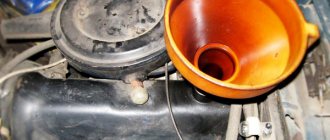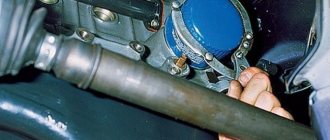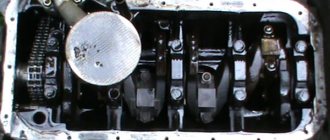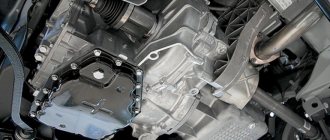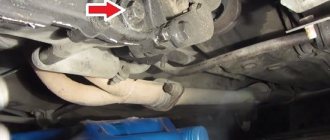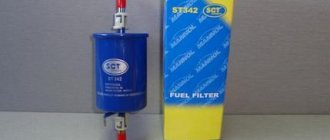What kind of motor can be installed on a “penny” instead of the standard one?
One of the main types of car tuning is improving the car engine. VAZ 2101 engines are an unplowed field in this sense. Some craftsmen install turbines on them in order to increase power and traction characteristics, others change the crankshaft and bore the cylinders, and still others simply change the engine to a more powerful one. But here it is important not to overdo it, because the car body is designed for certain loads, exceeding which can seriously harm the entire car.
Among the popular options for replacement, it is worth considering only power units that are similar in design and performance. For a penny, without any problems, you can install a 1.6 or 2.0 liter gasoline engine from the same Fiat Argenta or Polonaise.
The engine from Fiat Argenta can be installed on any classic VAZ without any special modifications
You can try the same engine from Renault Logan or Mitsubishi Galant, if you install them together with a gearbox. But the best option is a power unit from subsequent modifications of VAZs. These could be VAZ 2106, 2107, 2112 and even 2170. The engines from these cars are suitable both in size and in mounting to the gearbox.
Engine tuning 2101
Description of the VAZ 2101 engine tuning process
Tuning a penny engine, or as they also say, boosting the engine of a VAZ 2101, is a risky business, taking into account what is written above and taking into account the general wear and tear of the engine, if this does not stop, then let's go... first, let's look at it from the point of view of increasing the engine displacement. This is the most affordable method to improve your engine, increasing power and torque throughout the entire range. We will also describe the option of installing sports camshafts, boring cylinder head channels, compressors, etc. in detail below. But given the fact that your engine is a used 2101, hanging too much on it is fraught with consequences. To increase the power of the VAZ 2101 engine, let's start with cars produced in 1970-1974; they are distinguished by the ability to install Niva pistons with a diameter of 82 mm from the VAZ 21213 Niva, thanks to the thick-walled cylinder block. To prevent the compression ratio 2101 from sagging (a puddle in the pistons 21213), you need to take Niva pistons with a flat bottom or lighter pistons 2112 and cut off the displacer from the pistons. With a standard stroke of 66 mm, the engine volume will be 1.4 liters. We will get an increase in power, but the engine itself will be very high-speed. The increase in engine volume of the VAZ 2101 produced after 1974 is somewhat different; in order to save metal, the cylinder block became thin-walled, the maximum possible piston diameter is 79 mm from the VAZ 21011 or 2105. The piston stroke is increased to 80 mm. implemented by installing a crankshaft from a VAZ 2103 and connecting rods with a reduced center-to-center distance (129 instead of 136) or installing pistons with a reduced compression height, produced by TRT. Disadvantages of short connecting rods - the angle of inclination of the connecting rod, the greater the angle of inclination, the greater the force it presses the piston against the cylinder wall, the resistance to movement increases, lubrication conditions worsen, the cylinder walls wear out, the connecting rod works under greater load (especially in the center of the connecting rod), engine reliability 2101 is decreasing. Among the advantages, we note a good cylinder filling rate at medium and low speeds, a more homogeneous mixture, and improved combustion. The disadvantages of TRT pistons are their lower strength compared to standard VAZ 2101, thermal load on the ring and the likelihood of piston burnout. Increased piston stroke to 84 mm. VAZ 2130 crankshaft, as well as use TRT pistons, connecting rods shrink to 134 mm.
Boring of VAZ 2101 engine
The crankshaft and boring of the VAZ 2101 engine will give you the following volumes: - larger diameter piston, standard stroke 1.3 liters. 79x66 (cylinder diameter X piston stroke) ~64 hp. Maximum torque is about 95 Nm at 3400 rpm We get an analogue of the 21011 engine - a larger diameter piston, a standard stroke of 1.4 liters. 82x66 (until 1974) Such VAZ engines were not produced in series; there is little information about the construction of such engines. This is explained by the fact that in order to adequately use such a motor, you need a reinforced bottom, forged pistons, selecting the desired top shaft, etc., plus everything needs to be properly configured. The maximum speed of the correct configuration is more than 9000 rpm. The service life of such an engine is about 20 thousand, depending on operation. - standard piston, increased stroke 1.5 liters. 76x80 ~70 hp Maximum torque is approximately 105 Nm at 3000 rpm Analogue of the VAZ 2103 engine on a low block. This option is the answer to all questions about how to improve the VAZ 2101 engine. - larger diameter piston, increased stroke 1.6 liters. 79x80 ~75 hp Maximum torque approximately 115 Nm at 3000 rpm Analogue of the VAZ 2106 engine on a low block - larger diameter piston, increased stroke 1.7 liters. 82x80 (until 1974) ~ 80 hp Maximum torque ~125 Nm at 3200 rpm The configuration is the same as the engine from the Niva 2101 on a low block - a larger diameter piston, an increased stroke of 1.8 liters. 82x84 ~80 hp (until 1974 onwards) Maximum torque ~135 Nm at 3000 rpm The 2103 engine is more suitable for this volume
Tuning cylinder head VAZ 2101
A good option for upgrading the VAZ 2101 engine by removing the roughness of the channels, polishing the cylinder head channels and the VAZ 2101 manifold reduces the intake resistance, the power of the penny engine increases by about 5-8 horsepower, and the torque increases throughout the entire range. To polish, you need to remove the cylinder head and wash it with a mixture of gasoline, kerosene and solvent. After that, take an electric drill, wrap a rag around the drill, and put some sandpaper on top. The collector is fixed motionless in a vice and we begin sawing; after the bend of the collector, the same is done on a flexible rod. When modifying the cylinder head on a classic, it is necessary to grind off the protrusion at the connection of the cylinder head and the exhaust valve (about 3 mm), after which we use the same tool until we can insert the valve, after passing through all the channels and cutting off the bushings in them, we polish the channels from the seat side. When With additional boring of the channels, the VAZ 2101 engine is capable of producing about 75 hp. It is also recommended to use T-shaped valves on classics instead of tulip-shaped ones.
Camshaft for classics
Let me point out right away that the popular option of modifying the VAZ 2101 engine by installing a Nivov camshaft on a classic will not suit racers; the result will be a low-end VAZ engine, the tops will sag, and this is unacceptable. Optimal rollers for the VAZ 2101 with a modified cylinder head and increased volume to 1.5-1.6 urban STI-2, more sporty STI-3 or STI-4 sports wide-phase, the bottom may sag on it, but the engine will easily spin at more than 7000 rpm /min. We select a camshaft on a VAZ for a standard VAZ 2101 or VAZ 21011 engine, a good choice is Nuzhdin 10.5 256 or Nuzhdin 11.2. A correctly selected camshaft for 2101, as well as a modified head, when boosting the VAZ 2101 engine can show more than 80 hp .
Compressor for VAZ 2101
The market offers ready-made compressor installation kits for the VAZ 2101, for example an auto-turbo compressor with a pressure of 0.5 and 0.7 bar. The 0.5 bar auto-turbo compressor is installed with minimal modifications. When installing a compressor on a VAZ with a pressure of 0.5 bar on a modified cylinder head with a volume increased to 1.5-1.6 liters, the car will produce more than 120 hp. With standard volume up to 90-100 hp. The installation may reduce the service life of the VAZ 2101 engine.
Stages of replacing lubricant VAZ 2101
On classic Lada cars or the more familiar Zhiguli, a convenient drainage of used oil from the engine is provided. The oil filter is also easily accessible and can be reached from the engine compartment.
During the production of the VAZ 2101, a large number of modifications were produced, which were equipped with various engines. Experienced drivers note good maintainability, unpretentiousness in maintenance, as well as consumables.
There are no global differences in versions with different engine sizes when replacing, all actions will be almost the same.
Before starting to replace the lubricant, precautions should be taken. It should be noted that the drained waste will be at a high temperature. Since the replacement is carried out on a warm engine.
Draining waste fluid
Before starting the draining procedure, you should prepare tools, empty containers, as well as new liquids for subsequent filling. If additional protection is installed under the engine, it can also be removed for convenience.
Next, we perform the procedure for draining the liquid from the VAZ 2101:
- We lift the hood, under it we find the filler neck on the engine and unscrew the plug (Fig. 1).
Fig.1 Oil filler neck - Now we go down under the car and place a waste container in the drainage area. You can use a cut canister or an old bucket.
- Unscrew the drain plug using a 12mm hex key (Fig. 2).
Fig.2 Drain plug - The drain plug is not always located at the lowest point, so about 100-200 milliliters of waste may remain in the pan. To remove them, you can use a rubber bulb or a syringe with a hose attached to it (Fig. 3).
Fig.3 Pumping out residues with a syringe - Now you need to unscrew the old oil filter, which is located on the right side of the engine under the hood (Fig. 4).
Fig.4 Oil filter
To unscrew the filter element, it is advisable to have a special puller. If it is not available, you can try to unscrew the filter using improvised means. In this case, you can use, for example, an old alternator belt, a regular belt, a bicycle chain or a simple screwdriver.
Unscrewing the oil filter using improvised means
Using this method, you can drain the maximum amount of used oil, after which you can proceed to further actions. The main thing is not to forget, everything that we unscrewed must be put back in place.
Flushing the lubrication system
Flushing the engine on a VAZ 2101 should be carried out only in exceptional cases, which include:
- Purchasing a used car when you cannot know about the quality, as well as the regularity of lubricant replacements.
- During operation, the service replacement interval was repeatedly exceeded.
- Engine operation with constant frequent overheating, which contributes to coking and other deposits.
- In cases of switching to another type, for example from synthetics to semi-synthetics.
There are several types of flushes for the VAZ 2101 engine:
- Five- or seven-minute, capable of cleaning even the most difficult deposits. They must be used very carefully and strictly follow the instructions printed on the packaging. It is recommended to use them only when absolutely necessary. Since there is a high probability of causing premature wear of the sealing seals. And also clog the oil channels with particles of washed away carbon deposits.
- Special compounds that are added to the oil several hundred kilometers before the expected change. They are more gentle, but there is also a possibility of clogging of the oil channels.
- Flushing oil is the most gentle method of cleaning the engine from the inside. This composition is poured after draining the waste, the engine runs for 15-20 minutes, after which the liquid with deposits is drained. The absence of aggressive additives in the wash composition gently cleans the engine, but is not able to remove heavy contaminants.
- Regular oil that you are going to use when changing. This method is not so popular due to its high price.
Before flushing the VAZ 2101, you should weigh all the pros and cons. And also understand that it will not be possible to completely drain the liquid. Some of it will remain in the channels, which will then mix with the new oil.
Installing a filter, filling in new engine fluid
If the VAZ 2101 lubrication system is sealed and does not require repair work to eliminate leaks, you can proceed to adding fresh engine oil. In addition to the oil itself, we may need a new drain plug, its part number 14325301. As well as the original oil filter 2101-1012005.
Consumables
When everything is ready, let's move on to the bay:
- Replace the drain plug and replace it with a new one if necessary.
- We tighten and put the oil filter in place. Pre-lubricate the rubber sealing ring with fresh oil.
- Pour new oil into the filler neck.
- We check the level on the dipstick; it should be between the MIN and MAX marks.
- We start the engine, let it run for 10-15 seconds, then turn it off.
- After 5 minutes, check the level with a dipstick and top up if necessary.
There are several opinions regarding replacing the oil filter. Some car owners advise filling it with new oil before installation. However, in the official operating instructions for the VAZ 2101, as well as in information from well-known filter manufacturers, it is recommended to simply lubricate the o-ring.
Oil change on a penny
Now, directly, instructions for changing the oil on a VAZ 2101 car.
Note! For better oil drainage, you need to warm up the car. To fully warm up, drive a few kilometers and only then start changing the oil.
Changing the engine oil
After the car has warmed up and all the tools and oil have been prepared, you can begin to change the engine oil. So:
- First, drain the old oil. For this purpose, we need a 12mm hexagon. They need to unscrew the oil drain plug in the engine oil pan. Place the oil container under the hole and leave for about five minutes so that the oil drains well.
- In the meantime, while the oil is draining, you can not waste time and replace the oil filter. You can, of course, unscrew it by hand if you have the strength - there are craftsmen like that, but we will consider the option with a puller.
Another filter remover option
Take a pre-prepared oil filter puller and put it on the filter itself. With a sharp movement of the hand, the filter breaks off and can then be freely unscrewed by hand. There are times when the filter is so stuck to the block that it cannot be unscrewed even with a puller. In this case, it is broken through, a knob is inserted and unscrewed in this way. Or you can show your imagination and invent your own method. So:
- After this, install a new filter and tighten it with the same puller.
- Next, you need to screw the drain plug back into the pan and start pouring oil.
- Now you need to unscrew the filler plug, which is located in the cylinder head cover. We adjust the watering can to make it easier to get in and fill in the oil.
Watering can for easy filling of oil on VAZ 2101
- When adding oil, be sure to check the engine oil level on the dipstick.
Advice! Try to keep the volume of oil filled in the middle between the MIN and MAX marks on the dipstick. If there is not enough oil, the engine parts will be poorly lubricated and will fail faster. And if there is too much oil in the engine, this will create a high load on the engine seals and it will simply be covered in oil.
- Once the required level is reached, tighten the plug.
- Start the engine for the first time. Don't be alarmed that it will be a little noisy right away - this is normal. The car needs to pump oil into the system and after a few seconds the noise will subside.
- A sign of a successful oil change is the absence of leaks in the block and drain plug, as well as a non-lit oil indicator on the instrument panel.
The oil change on the VAZ 2101, or rather in the engine, has been completed.
Changing the gearbox oil
Now let's go further through the car and consider the process of changing the oil in the variable gearbox. By the way, if you were unable to get a special syringe for changing the oil in the gearbox, then you can use a watering can with a long hose.
So:
- We take a 12mm hexagon and unscrew the drain plug, which is located in the bottom lid of the box.
- If there is oil there, give it time to completely drain from the gearbox housing, and then tighten the plug back. Don't break the thread!
Oil change VAZ 21013
- Now we will also need a key for 17. We use it to unscrew the gearbox filler plug.
- Now we take a syringe or insert the end of the hose into the filler hole of the box, and take the watering can higher - for example, into the engine compartment.
- We fill the syringe with oil and squeeze it into the box. In the case of a watering can, we simply pour oil into it.
- Fill the oil with a syringe several times. It will require 1.4 liters.
- The filler hole serves as the oil level. The conclusion is to fill the oil until it flows out of the hole. Then quickly screw in the plug.
- Wipe off any remaining oil on the gearbox housing with a cloth and check for leaks. If there is a leak, it must be repaired.
This is roughly what a checkpoint should look like
This is how the oil in the VAZ 2101 gearbox is changed.
Changing the oil in the rear axle of a VAZ 2101
Here the essence of the process is practically no different from changing the oil in the gearbox:
- Use a hexagon to unscrew the drain plug.
- Drain the oil into a container.
- We screw the plug back, having first cleared it of metal shavings.
- Unscrew the filler plug.
- Fill the oil with a syringe or a special homemade device. About 1.3 liters of oil will be required.
- Add to the level and tighten the cap.
- We wipe and check the tightness.
Changing the oil in a VAZ 2101
That's all.
Frequency of lubricant replacement
According to official regulations, changing the gearbox oil on a car with a carburetor or injection engine should be carried out every 60 thousand kilometers or once every three years. It all depends on what happens faster. There are other nuances that affect the frequency of changing the lubricant, for example, the characteristics of the oil used. If the owner fills the gearbox of his car with low-quality fluid or motor oil instead of transmission oil, then the frequency of its replacement will be significantly lower. In this case, the structural elements of the gearbox may be destroyed from the inside.
Engine oil
Any big thing can be done if it is divided into many small tasks - Henry Ford once said. And in truth, it would seem that such a job as changing engine oil can be completed without haste if you prepare the necessary tools and consumables in advance.
Required Tools
- A 12 mm wrench for unscrewing the drain plug on the oil pan. If the plug is not standard, an adjustable wrench may be useful (it is better to always have it on hand).
- New oil of the required quality and viscosity, oil filter.
- Empty container for draining old oil from the crankcase, clean rags.
- If the engine is covered from below with protection, then it will most likely also need to be removed. Look at what bolts hold this protection in place and select the right tool before work.
- Of course, lay down a rag so that it lies on the ground and on the rag. The ideal monitor lizard is an inspection hole or overpass.
Engine oil change period (interval or interval)
Manufacturers (not only VAZ but also other brands) take the replacement interval of 15 thousand km as a basis and recommend “relying” on this figure. However, many car enthusiasts perform maintenance earlier, already at 10 thousand. They justify this with terrible roads and the quality of fuel and lubricants.
If you change fluids ahead of schedule, you are sure that it is at this moment that the engine is lubricated by oil and not by black slurry that looks like water. Whether to change it sooner or not is up to everyone to decide for themselves, and everyone pays for major repairs out of their own pocket. Draw your own conclusions based on this.
Which one to pour and how much?
Most VAZ 2101 owners choose engine oil viscosity 10W-30 and 10W-40, of course semi-synthetic. For such old engines (which, by the way, were developed in the 70s-80s), no one suspected synthetic oils. At that time, mineral water was popular. However, today buy semi-synthetics with a viscosity of, for example, 10W-40 and ride safely for a whole year until the next replacement.
Along with the lubricating fluid, the cleaning filter must also be changed. For Soviet cars today there is a whole “ocean” of affordable filters from different companies on sale, several examples that are suitable for “Kopeyka”.
- M-001 Industrial business ~ $1.5;
- Z-104 Zollex ~ 1.5$;
- 2101-1012005 HOLA ~ $2;
- WL7067 WIX ~ $2 and many others.
For our service, you will need to buy consumables in the form of engine oil in the required quantity and an oil filter suitable for the engine. Of course, the air filter also needs to be changed, but here we are only discussing the aspects of changing the oil.
How to replace
- We warm up the engine to 45-50 degrees. Warm oil has better fluidity and will drain better from the engine during a complete replacement. Our task is to remove as much as possible the old dirty and used fluid that no longer has useful properties from the engine and fill it with new one. If a lot of old dirty oil remains in the crankcase, it will be swept away with the new one and will worsen its beneficial properties. Warm up the engine for 5-7 minutes before starting, this will be sufficient.
- For easy access to the drain plug (and in some models the oil filter is also attached from the bottom) and the bottom of the car as a whole, you need to jack it up or drive into an inspection hole (the best option). Also, some models may have engine crankcase “protection” installed.
- We open air access to the crankcase by unscrewing the filler cap and dipstick.
- Place a large container (equal to the amount of oil being poured).
- Unscrew the drain plug with a wrench. Sometimes the drain plug is made like a regular “bolt” under an open-end wrench, and sometimes it can be unscrewed using a four- or hexagon. Don't forget to wear protective gloves, the oil will most likely wake you up warm, but you need to be careful.
- We wait about 10-15 minutes until the waste flows into a basin or cut-off plastic canister.
- Optional but very effective! Flushing the engine with a special liquid is not included in the maintenance regulations and is not mandatory - but. By getting a little confused, you will be much better at flushing out the old, black oil from the engine. In this case, wash with the old oil filter for 5-10 minutes. You will be surprised at the black oil that comes out with this liquid. This liquid is very easy to use. A detailed description should appear on the flushing fluid label.
- Changing the sedum filter. In some models, it is not the filter itself or the filter element (usually yellow) that is changed. Impregnating the filter with new oil before installation is a mandatory procedure. Lack of oil in the new filter before starting the engine can cause oil starvation, which in turn can cause filter deformation. Overall this is not a good thing. Also remember to lubricate the rubber O-ring before installation.
- Fill in new oil. Having made sure that the drain plug is screwed in and a new oil filter is installed, we can begin to fill in new oil using the dipstick as a guide. The level should be between the minimum and maximum marks. Also, you need to remember that after the first start of the engine, some oil will leave and the level will drop.
- In the future, when the engine is running, the oil level will probably change; be careful during the first few days of operation. Recheck the oil level using the dipstick after the first start.
What kind of oil to pour into the VAZ 2101 engine
- mineral oils (natural - used for used engines);
- semi-synthetic motor oils (artificial - for extreme trips);
- synthetic oils (semi-synthetic - for general purpose).
To make the right choice, you need to be guided by the manufacturers' data. You also need to take into account that artificial and semi-artificial oils contain additives that destroy gaskets on older car models. For this reason, you should not use the engine of an old VAZ 2101 with artificial oil. Otherwise, it may result in a quick breakdown. As for viscosity, it is indicated by two numbers and a letter between them, for example 5W-50. The first part of the marking indicates viscosity at negative temperatures. The second is when heated.
When choosing oil for a VAZ 2101 engine, you must:
- Give preference to products recommended by the manufacturer.
- If the mileage is more than one hundred thousand kilometers, it is recommended to replace synthetic oil with semi-synthetic oil.
- It is recommended to change the oil every 10-15 thousand kilometers.
- In cars manufactured before 2000, it is recommended to use standard type oils (AZMOL SUPER 15W-40, 20W-40; SHEL HELIX 10W-40, etc.).
- In cars after 2000, use “super” oil (LADA-SUPER 5W-40, 10W-40, 15W-40; MOBILE SUPER M15W-40, etc.).
- For fast trips, it is better to use a substance with a high degree of viscosity when heated (0W-50, 5W-50, 10W-50, etc.).
- For trips in winter, the best option would be 10W-40.
Table “Selection of oil according to VAZ recommendations”
| Minimum engine cold start temperature, ͦС | SAE viscosity grade | Maximum ambient temperature, ͦС |
| -35 | 0W-30 | 25 |
| -35 | 0W-40 | 30 |
| -30 | 5W-30 | 25 |
| -30 | 5W-40 | 35 |
| -25 | 10W-30 | 25 |
| -25 | 10W-40 | 35 |
| -20 | 15W-40 | 45 |
| -15 | 20W-40 | 45 |
When servicing and purchasing accessories for your “iron horse,” it is extremely important to adhere to the standards and instructions of the manufacturer, which can be found in the technical data sheet of the car.
Choosing oil
Synthetics, Semi-synthetics or still Mineral water - that is the main question! So:
- It’s clear: mineral water is the cheapest option, it recommends a minimum mileage between subsequent replacements
- Flushing the oil system is mandatory at every replacement due to the fact that mineral water likes to leave behind all kinds of deposits
- Semi-synthetic oil - costs more and, of course, functions more stably and retains the necessary properties throughout its entire service life
- It flushes the engine better, but during harsh operation (at high temperatures, or poor fuel quality, etc.) it also quickly loses valuable properties.
- Synthetics are the most expensive, but they are the most stable! is produced artificially in the laboratory and is almost flawless, as it retains all its valuable properties in any conditions, cleans, washes, cools, lubricates, and also freezes only at extremely low temperatures
Choosing a lubricant according to API classification
As an example, let's look at the API SJ/CF-4 marking:
- The first letter "S" means for gasoline engines
- If the first letter is “C”, then the oil is intended for a diesel engine
- Everything here is clear and quite simple, the higher the letter in the alphabet, it means the oil is more modern and of higher quality, for example, marked SH, SJ, SL, SM.
- It should be understood that if, for example, you fill a VAZ 2101 engine with SM class lubricant, of course it won’t get any worse, but it’s also better!
- Do not forget that the VAZ 2101 engine was developed many years ago, and there was no such oil then, so such a purchase is a useless waste (overpayment) of money
Now we select according to the SAE classification
On lubricants produced abroad, and not only, similar markings are often found: 0W20 or 5W30 or 10W40 and so on. To understand it, it is important for you to know the meaning of the numbers. This is the most difficult question:
- On the one hand, the engine manufacturer, which specifically prescribes the oil for each unit that must be poured into it
- On the other hand, there are conditions not foreseen by the engineer: for example, low start-up temperatures or engine tuning, which implies an increase in lubricant temperature, higher pressure, and so on.
And so let’s understand the meaning of these numbers, they reflect temperature viscosity:
- The first number indicates at what temperature the lubricant remains fluid and can be pumped by an oil pump
- The gradation is very simple: for example, take 0W(-40), 5W(-35), 10W(-30), and so on
- Oil sellers often point to the first number as the freezing point of the lubricant; in fact, this is the temperature at which the lubricant loses fluidity (stops flowing, thickens)!
- And the temperature at which it is not pumped by the pump is 7-10 degrees higher, this is important to know in order to avoid problems with starting the engine in winter
- The second number shows us the high temperature viscosity! And not any ability of oil to work at high temperatures and other crap that we don’t understand!
- The higher this number, the thicker the lubricant becomes at the operating temperature of the engine (when the engine has warmed up, it no longer cares what the temperature is outside)
- You can verify this by opening any manual for any oil and reading the column in its physical and chemical characteristics: “Kinematic viscosity at one hundred degrees Celsius”
As for the brand, you can choose to use lubricants from both domestic and foreign manufacturers:
- Among the domestic ones, the following are in demand: Reksol Universal (1OW-30 or 1OW-40), Ufoil (1OW-30 or 15W-40), Ufalub (15W-40), Novoil-Motor (15W-30 ), "Angrol" (1OW-30)
- There is also quite a wide selection of foreign brands: Castrol GTX (15W-40), Shell Super Plus (1OW-40 or 15W-40), Elf Sporty (1OW-30 or 15W-40), Agip Supermotoroil (1OW-30 or 15W-40 ),Esso Ultra Oil X (1OW-40)
Replacement frequency, what oil to fill
According to the manufacturer's regulations, service changes of engine oil on the VAZ 2101 are carried out after 8,000-10,000 kilometers or at intervals of 1 year. But some car owners consider this interval to be a little too high, recommending that it be shortened taking into account operating conditions.
It is recommended to use semi-synthetic with a viscosity of 10W-40 as a lubricant. The following motor oils are most popular among model owners:
- Lada Professional 10W-40
- Lukoil Genesis Advanced 10W-40
- Shell Helix HX7 10W-40
- Total Quartz 7000 10W-40
From this list, anyone can choose based on preference, price or love for the brand.
When using this car in winter, you should select oil taking into account the climate zone, as well as the recommendations of AvtoVAZ. Viscosity 5W-40 will allow you to operate the car down to -30°C, and 0W-40 up to -35°C.
If you use motor oil of different viscosities for winter and summer, but of the same brand and manufacturer, then flushing is unnecessary.
How much oil is in the engine lubrication system, volume table
Oil change VAZ 2101
VAZ 2101 is a sedan car of Soviet origin. In 1972, the Volzhsky Automobile Plant received the international Golden Mercury award for the production of the VAZ 2101 model. The title of “Best Domestic Car” was awarded to the VAZ 2101 based on the results of a social survey of Russian citizens in 2000 (conducted by Za Rulem magazine). During production (which was 18 years from 1970 to 1988), the Volzhsky plant produced more than 4.85 million VAZ 2101 sedan cars (including modifications).
- VAZ-2101 “Zhiguli” - the basic version with a 1.2 liter engine. (year of manufacture 1970-1983);
- VAZ-21011 “Zhiguli-1300” - people say “zero eleven” - some changes to the exterior and interior with a 69 hp engine. with a volume of 1.3 l (production 1974-1983).
- VAZ-21013 “Lada-1200s” - reduced engine capacity - 1.2 liters (1977-1988).
Power steering (power steering)
For the VAZ 2101 (or as it is also called Lada, Zhiguli, Kopeika), the presence of power steering is in itself a high-class option. After all, on most cars there are simply no power steering systems. If you get your hands on a car with this auxiliary option, we congratulate you.
Power steering helps you turn the steering wheel along with the wheels, while you spend several times less force than a car without a power steering system.
There are marks on the power steering expansion tank by which you can understand whether the fluid level is currently high or, conversely, low and needs to be added. A quick inspection of the power steering system can solve many problems along the way, so look under the hood once a month.
What should you pay attention to?
- Monitoring the power steering fluid (oil) level and its color in the expansion tank;
- Checking the drive belt for the power steering pump;
- General condition of hoses (inspection for cracks, abrasions and chips);
- Hose connection points.
How to change
Changing the power steering fluid (oil) can be done in several ways, including partially changing the fluid and completely changing it. The first method is faster and easier, the second is better.
Partial replacement
Partial replacement of power steering fluid involves pumping fluid out of the power steering expansion tank using a large syringe or bulb. After the tank is completely empty, fill in fresh fluid to the maximum mark. Start the car and turn the steering wheel left/right. After a few minutes, turn off the engine and check the color of the power steering fluid. If it is too dark, repeat the procedure until the desired result.
Complete replacement
To replace the power steering fluid, remove the air duct and the reservoir with power steering fluid. Pour the old liquid from the barrel into another container. When draining, pay attention to the condition of the old oil and the presence of foreign metal particles. If they are noticeable, this may indicate wear on the pump. To completely drain the power steering, you can rotate the steering wheel left and right.
conclusions
By reading this article and looking at the photos, you have clearly seen that it is quite possible to independently change the oil on a VAZ 2101 car. If this information was not enough, watch the video. Monitor the condition of your car. Check the oil level on time and change it on time.
Every day before leaving, pull out the dipstick and look at the level. Once every 20,000 km, check the oil level in the gearbox and rear axle. If necessary, add it there. In a word - take care of the car and it will serve you faithfully.
Viscosity and Specifications
At the manufacturer's factory, a special high-quality all-season oil is poured into the engine, which is suitable for use at any time of the year, with the exception of particularly cold climatic zones.
You can add oil of a different specification to the engine. The viscosity of the oil should be selected in accordance with the data on. If the air temperature only briefly falls outside the temperature range shown in the figure, the oil should not be changed.
Gasoline engines
A – all-season oils with increased anti-friction properties, specification VW 500 00.
B – all-season oils, specification VW 501 01.
– all-season oils, API-SF or SG specification.
Diesel engines
A – all-season oils with increased anti-friction properties, specification VW 500 00 (for turbocharged diesel engines only when mixed with oil specification VW 505 00).
B – all-season oils, specification VW 505 00 (for all diesel engines),
– all-season oils, API-CD specification (for diesel engines with turbocharging only in case of emergency for topping up).
– all-season oils, specification VW 501 01 (for turbocharged diesel engines only when mixed with oil specification VW 505 00).
Quality of motor oils
All-season oils of specifications VW 501 01 and VW 505 00 are relatively inexpensive and have the following qualities:
– possibility of year-round use in temperate climate zones;
– excellent cleaning properties;
– good lubricity at any temperature and engine load;
– stability of initial properties over a long period of time.
Multi-grade oils with improved anti-friction properties according to the VW 500 00 specification also have additional advantages:
– possibility of use at almost any outside temperature;
– low engine power losses due to friction;
– facilitate starting a cold engine even at very low temperatures.
Warnings
Seasonal oils, due to their specific viscosity-temperature properties, usually cannot be used all year round, so they should only be used in appropriate climatic zones.
When using all-season SAE 5W-30 oils, it is necessary to avoid prolonged operation of the engine at high speeds and constant heavy load on the engine. These restrictions do not apply to multi-grade oils with improved antifriction properties.
Motor oil additives
Additives that reduce friction losses should not be added to engine oil.
Mixing oils
This and similar questions interest many car enthusiasts. Unfortunately, oils cannot be mixed, even if they are oils from leading manufacturers (Shell, Mobil, British Petroleum). Each company produces commercial oils by adding a whole range of additives to the oil base, the chemical composition of which is kept secret. Therefore, when mixing high-quality oils of the same purpose, manufactured in accordance with the requirements of existing motor oil classification systems, but using technologies from different companies, low-quality mixtures may be obtained due to incompatibility of additives. Oils from different companies are interchangeable; engine builders often indicate the possibility of using such oils. But this does not mean that they can be mixed. The API and ACEA classification systems require the same testing methods (laboratory, bench - motor, etc.) for oils from different companies. If desired (or necessary), automobile manufacturers may introduce additional tests (or more stringent conditions) for oils.
The same applies to mixing mineral or synthetic oils (sometimes even from the same company). Synthetic oils, such as hydrocarbon oils, from the same brand can be mixed. In this case, the oil manufacturer gives appropriate recommendations and bears responsibility. However, it is not uncommon for oils to deteriorate in quality when mixed. As a result, the engine may knock as the mixture of incompatible oils turns to jelly.
Under no circumstances should imported and domestic oils be mixed, especially with the addition of domestic additives. Neither the seller nor the consumer knows the composition of the additives that are added to the oils. Some oils of “domestic origin” are produced by “firms” that do not even have basic knowledge of petroleum products. Sometimes such “specialists” use used oils (even without proper regeneration) to produce “commercial” ones. Use only oils recommended in the owner's manual.
No “cleaners” (Tokron, etc.) can increase the octane number of gasoline. For this purpose, special additives are used - anti-knock agents, which are added during the production of gasoline at oil refineries, or additives. The cause of detonation (a metallic knock is heard while the engine is running) and glow ignition (the engine continues to run when the ignition is turned off) may be carbon deposits in the combustion chamber.
The increase in compression in the system “with the introduction of certain additives” does not occur due to viscosity additives, since they do not contain them in their composition, but for other reasons.
It is not advisable to reduce oil waste in an old engine and increase compression in the cylinders by using high-viscosity oils, since this will actually lead to an increase in compression in the cylinders, but not for long. Engine repairs will cost more in the future.
The cause of “acoustic” noise in an old engine is its wear and tear, so repairs and subsequent use of high-quality oil will be cheaper. You can reduce the gaps with additives, but the feasibility of this should be understood so as not to harm the engine.
We must make it a rule: use high-quality oil of the same brand that matches the engine and do not mix it with synthetic (or semi-synthetic) oil. The engine will thank you for this with trouble-free operation. Do not buy oil secondhand, as the packaging is easy to counterfeit.
Changing the oil and oil filter
Periodically changing the oil and oil filter is the most important preventative maintenance procedure. During operation, engine oil ages - it becomes liquid and contaminated, which leads to premature engine wear.
The oil change should be carried out immediately after a trip with the engine not yet cooled down, so that the oil drains better along with contaminants.
Raise the car on a lift or place it horizontally on an inspection ditch.
Remove the lower engine splash guard.
V6 petrol engines
Unscrew the oil filter ( ). If the filter is difficult to unscrew, use a special key Hazet 2171–1.
Place an oil container under the oil drain hole and unscrew the plug. If necessary, press down on the plug as you unscrew it to prevent the oil from draining prematurely, and drain the engine oil.
Once the oil has completely drained, wipe off the oil around the drain hole and screw in the oil drain plug with a new O-ring.
Wipe the oil filter installation area and screw in a new oil filter.
V8 petrol engines
The oil filter is located at the right rear of the engine.
On V8–5V engines there is no oil drain plug on the oil filter cover.
Place a container to catch the oil under the drain hole and unscrew the plug. If necessary, press down on the plug as you unscrew it to prevent the oil from draining prematurely, and drain the engine oil.
Unscrew bolt 1 of the fastening and remove the cover and oil filter element.
Wipe the oil filter housing and cover and install a new oil filter element 5 ( ).
Lubricate sealing ring 4 with fresh engine oil, install cover 3 with sealing ring in place and secure with bolt 1 with new seal 2, tightening it to a torque of 25 Nm.
Screw plug 7 with a new sealing ring 6 into the filter cover and tighten it to a torque of 50 Nm.
Wipe off the oil around the drain hole and screw the drain plug into the oil pan, tightening it to a torque of 35 Nm.
Fill the engine with oil of the appropriate brand.
On V8–5V engines, tighten the oil filter cover bolt to a torque of 25 Nm, and the plug to the oil pan to a torque of 50 Nm.
V6 TDI diesel engines
Remove sealing ring 2 and filter element 3 of the oil filter.
Clean the oil filter housing and install a new filter element 3.
Install a new sealing ring 2 on cover 1 and screw the cover onto the body, tightening it with a torque of 25 Nm.
Place an oil drain container under the drain hole and unscrew the plug, pressing down as necessary as you unscrew to prevent the oil from leaking out prematurely, and drain the engine oil.
When the oil has completely drained, wipe the oil around the drain hole and screw in the plug with a new sealing ring, tightening it to a torque of 25 Nm.
Fill the engine with oil of the appropriate brand.
VAZ 2101 is a sedan car of Soviet origin. In 1972, the Volzhsky Automobile Plant received the international Golden Mercury award for the production of the VAZ 2101 model. The title of “Best Domestic Car” was awarded to the VAZ 2101 based on the results of a social survey of Russian citizens in 2000 (conducted by Za Rulem magazine). During production (which was 18 years from 1970 to 1988), the Volzhsky plant produced more than 4.85 million VAZ 2101 sedan cars (including modifications).
Modifications of "Kopeyka"
- VAZ-2101 “Zhiguli” - the basic version with a 1.2 liter engine. (year of manufacture 1970-1983);
- VAZ-21011 “Zhiguli-1300” - people say “zero eleven” - some changes to the exterior and interior with a 69 hp engine. with a volume of 1.3 l (production 1974-1983).
- VAZ-21013 “Lada-1200s” - reduced engine capacity - 1.2 liters (1977-1988).
Oil seals VAZ 2107 (dimensions)
| Designation | Dimensions (mm) | Name | ||
| D | d | H | ||
| 2101-3401026 | 37 | 19,3 | 10 | Steering shaft oil seal |
| 2101-1701043 | 47 | 28 | 8 | Gearbox seal VAZ 2107 (primary shaft) |
| 2101-1701210 | 56 | 32 | 10 | Secondary shaft oil seal VAZ 2107 |
| 2101-1005034 | 56 | 40 | 7 | Crankshaft oil seal (front) VAZ 2107 |
| 2101-1005160 | 90 | 70 | 10 | Rear crankshaft oil seal |
| 2101-2402052-01 | 68 | 35,8 | 12 | Rear axle oil seal VAZ 2107 (gearbox) |
| 2101-3401023 | 43 | 28,6 | 10 | Steering bipod shaft oil seal |
| 2101-2401034 | 45 | 29 | 8 | Axle shaft seal VAZ 2107 |
| 2101-1307013 | 36,6 | 15,5 | 20,3 | Oil pump VAZ 2107 (water pump) |
| 2101-1007026 | 10,5 | 8 | 10,2 | Oil cap (oil scraper) |
| 2101-3103038 | 57,15 | 40 | 10 | Hub seal |
Design Features
Initially, at the design stage, a feature for the engine was the overhead camshaft:
- The piston stroke decreased by 5.5 mm compared to the Fiat 124 standard;
- the cylinder diameter increased by 3 mm.
This modernization ensured acceleration and rapid acceleration. In addition, the 2101 engine had the following design nuances:
- timing chain transmission;
- unfinished carburetor models;
- major overhaul after 20,000 km.
Valve train chain
Immediately after the release of the first internal combustion engine of this series, the manufacturer AvtoVAZ released a manual in which it indicated which oil to fill in the engine and provided a description of the internal combustion engine parameters to increase the service life of the engines. Thus, the owners of the next three generations of engines had no questions about what oil to pour and in what quantity.
Timing mechanism
Engine malfunctions and repairs 2101
Engine VAZ 2101 1.2 l. base for the entire classic VAZ family, contrary to some opinions that the VAZ 2101 has a Fiat engine, this is not entirely true, the 2101 engine was created from a crude prototype of the FIAT 124 engine. Due to the increased center-to-center distance, in relation to the Fiat engine, it allowed VAZ engineers to repeatedly increase engine displacement. Subsequently, 1.3 l., 1.5 l., 1.6 l engines were built from it. up to 1.7 l. and 1.8 l. The kopek engine is an in-line 4-cylinder carburetor with an overhead camshaft, the gas distribution mechanism 2101 has a chain drive. The motor belongs to the Zhiguli so-called “classic” series with a low block. The service life of the VAZ 2101 engine, in quiet operation and timely maintenance, reaches 180-200 thousand km.
On models 1970-1974, the penny engine has higher reliability, since production was controlled by specialists from FIAT. Before describing the endless problems of the engine, I would like to answer the question where is the engine number on the VAZ 2101. We stand in front of the car, on the left side, looking at the front of the engine block, in the area where the breather and crankshaft pulley are located. Look carefully, the writing is small. Let's move on to the problems of the VAZ 2101; on engines there is a problem of increased camshaft wear. The engine also needs systematic (every 7-10 thousand km) adjustment of the valve clearances; this will be indicated by a loud knocking noise when the engine is idling, heard from the driver’s seat with the hood closed. Weber and Ozone carburetors constantly require CO adjustment and cleaning. High oil consumption of VAZ 2101, up to 0.7 liters per 1000 km. The VAZ 2101 engine gets hot very often, the reason for this is a malfunction of the cooling system thermostat. Occasionally, the cause of overheating of the VAZ 2101 engine can be a fan failure, a pump malfunction, the use of gasoline with an octane rating higher than the recommended one, and a number of various minor reasons. It is very common for a VAZ 2101 engine to smoke, for which there are a number of main reasons: burnt out piston rings, rich carburetor, faulty valve seals, wear of valve guides and much, much more. Most often, this is a sign that you are waiting for a major overhaul of the VAZ 2101 engine. It is also not uncommon for the VAZ 2101 engine to malfunction, which leads to its rapid wear. Among the reasons are a malfunction of the ignition system, which increases fuel consumption, loss of tightness in the cylinder during compression, timing faults, too lean mixture, piston or valve failure, incorrect valve adjustment, etc. Malfunctions of the VAZ 2101 engine can be listed endlessly, the most basic ones are described above , in other cases you need to contact the specialists.
Leaks and problems
The higher the mileage of the VAZ 2101, the more problems appear, as in principle with any car. Most often this is due to natural wear and tear of the engine, causing oil to burn. Although the manufacturer allows for a small consumption.
There can be many reasons why an engine eats oil. And in each case they can be individual. But, over the years of the model’s existence, we can talk about the most common places where leaks occur.
If the breather is spewing or throwing oil, or if there is oil in the exhaust manifold, this may indicate a serious problem with the oil rings. In this case, you can try decoking with dimexide. But it is better to use special auto chemicals designed for these purposes.
A leak from under the valve cover may be due to a worn gasket. Sometimes simply replacing the gasket does not solve the problem. Since the cover itself may have significant curvature. Therefore, in some cases it will have to be replaced.
A white emulsion in the engine or on the oil filler cap may indicate condensation. This is a common occurrence when temperatures change from minus to plus, mainly in autumn or spring.
But if the emulsion is also observed on the dipstick, then this is already a sign of more serious problems. Most often we can talk about a broken cylinder block gasket. And in rare cases, a cracked cylinder head may be to blame.
Also, with this problem, you can find oil in the expansion tank. Sometimes, simply replacing the gasket is not enough. It may be necessary to grind the head itself, and this is completely different money for repairs.
All this is general information, which may manifest itself differently on each specific vehicle, since everyone’s operating modes are different. The same applies to places of leaks or oil leaks. Therefore, it is impossible to identify the cause from a distance.
Malfunctions: causes, elimination
Unlike motors with a timing belt drive, the 2101 valve bends much less frequently. The main malfunctions of the internal combustion engine are:
| Breaking | Cause | Elimination |
| Blue smoke | rupture of valve seals, bushings and cylinder head gaskets, wear of rings | replacement of consumables and seals |
| Engine overheating | Fan or thermostat failure | replacement of attachments |
| Oil consumption increases | leaks in valve covers, worn out pistons/cylinders | replacing gaskets, installing the next repair size of pistons and rings |
| Knock | crank bearings, connecting rod bearings, increasing valve clearance | replacement of consumables field of qualified diagnostics |
The speed limit of “kopecks” with 2101 engines was 145 km/h, and the car accelerated to “hundreds” in 18–20 seconds in a straight line.
Car VAZ 2101 Kopeyka
Oil pressure sensor
If the oil pressure sensor lights up on a Volkswagen Polo, then a fascinating set of checks of the engine and individual components awaits you. What could cause the sensor to light up?
- Low level of oil pressure in the engine. The simplest option is to check the dipstick, if you add too little to the required level.
- Oil too old. Look at the color of the oil, rub it with your fingers (you should feel oily). If the oil is too old, it is better to change it to a new one.
- Oil pump malfunction.
- The oil pressure sensor has failed. If you checked the previous steps and nothing helped, check the sensor itself. A visual inspection will help determine the external condition of the device. If necessary, replace with a new one. It happens that the sensor is covered in oil, this may indicate that the leak is coming through the sensor. Of course, such a part must be replaced immediately.
How to replace
Replacing the sensor does not require much effort. At the rear of the cylinder block (where the unit number is indicated), press the wire lock and remove the terminal. The sensor itself is unscrewed with a key x 22. When installing a new sensor, make sure that there is a sealing washer.
How to change engine oil on a VAZ 2101-VAZ 2107?
Drain:
1) First you need to remove the cap from the oil filler neck.
2) Next you will need to unscrew the drain plug.
3) Whatever pollutes the environment, place some container for drained oil.
4) After the oil has poured out of the hole, you will need to screw the plug back on.
5) Now unscrew the oil filter and remove it.
Note!
You can unscrew the oil filter by hand, but if nothing comes out, use a special wrench!
Pouring:
If you are going to fill in with a different brand of oil, then you need:
1. Drain the old oil. (We do not change the oil filter!) 2. Fill in new oil to the bottom mark on the dipstick. 3. Start the car and let it run for about 10 minutes. (You can’t move away!) 4. Turn off the car and drain the oil. 5. Replace the oil filter with a new one. 6. Now you can fill in new engine oil. (You need to fill up to the top mark on the dipstick!)
If you are not going to change the brand of oil, then you need:
1. First, pick up a new oil filter. 2. Then pour new engine oil into it, one-third of the filter volume. (A third of the volume is slightly less than half the filter.) 3. Then lubricate the filter O-ring with new engine oil. 4. Then screw the new filter into place. (Wrap it with your hands!) 5. Now you need to pour clean oil into the oil filler neck (For convenience, you can use a funnel!) 6. After pouring the oil, start the car and let it run for a few minutes. (You should not drive the car right away!) 7. While the engine is running, look to see if oil is leaking from under the drain plug or oil filter.
Important!
1. The oil must be drained at engine operating temperature! (Draining oil on a cold engine is “PRIMBERED”)
2. Also, when draining used oil, be careful, because the oil is hot!
For newbies!
Question: What does the oil filter look like? Note: The oil filter may come in different colors! Answer:
A video has been prepared below in which you will familiarize yourself in detail with the instructions for changing the oil:
All motorists know that a car simply cannot exist without oil. And oil, in turn, like everything else, tends to deteriorate and requires replacement and topping up at a certain time. This article will discuss in detail changing the oil in a VAZ 2101 - how to change the oil in the engine, gearbox, and rear axle. Questions about choosing oil will be discussed, what tools will be needed to change the oil yourself, and here you will also find useful tips on the frequency of oil changes and other small but important points. So, let's start in order.
Maintenance
Considering the design of the internal combustion engine, the manufacturer recommends the following maintenance schedules:
| Maintenance object | Time or mileage (whichever comes first) |
| Valve train chain | replacement after 100,000 km |
| Battery | 1 year/20000 |
| Valve clearance | 2 years/20000 |
| Crankcase ventilation | 2 years/20000 |
| Belts that drive attachments | 2 years/20000 |
| Fuel line and tank cap | 2 years/40000 |
| Motor oil | 1 year/10000 |
| Oil filter | 1 year/10000 |
| Air filter | 1 – 2 years/40000 |
| Fuel filter | 4 years/40000 |
| Heating/Cooling Fittings and Hoses | 2 years/40000 |
| Coolant | 2 years/40000 |
| Oxygen sensor | 100000 |
| Spark plug | 1 – 2 years/20000 |
| Exhaust manifold | 1 year |
With timely cleaning, the lubrication, cooling and fuel supply system operates longer without major repairs.
How much to fill (filling volumes)
- The fuel tank size is 39 l (AI 92-95 gasoline is used).
- The cooling system will absorb 8.65 liters of liquid.
- The lubrication system will require 3.75 liters of engine oil with a viscosity of 0W40, 5W30, 5W40, 10W30, 10W40, 15W40.
- The gearbox will “ask” for replacement - up to 1.6 liters of 75W90 or 80W90 oil.
- The rear axle needs to be filled with 1.3 75W90 or 80W90. The same as being poured into a gearbox (transmission).
- Brake system - 0.38 liters of DOT4 fluid.
Oil selection table by season (winter, summer)
| Year | Viscosity SAE all season from +25 to -25 °C | winter from -35 to 0 °C | summer from 0 to +35 °C |
Gasoline API Diesel API Type Recommended manufacturers
197515W-20 10W-20 10W-30
| 5W-20 10W-20 | 20W-20 25W-20 |
SGCD-IImineralkaRosneft, Mannol, Lotos, Total, AGA, Lliqui-Moly197615W-20 10W-20 10W-30
| 5W-20 10W-30 10W-20 | 20W-20 25W-20 |
SGCD-IImineral Kixx, G-Energy, Rosneft, Mannol, Lotos, Lliqui-Moly, Select, Esso197715W-20 10W-20 10W-30
| 5W-30 5W-20 10W-20 | 20W-20 25W-30 25W-20 |
SGCD-IImineral Mannol, Lotos, Total, AGA, Lliqui-Moly197815W-30 15W-20 10W-30
| 5W-20 10W-20 | 20W-30 20W-20 25W-20 |
SGCD-II mineral water G-Energy, Rosneft, Mannol, Lotos, Total, AGA, Lliqui-Moly197915W-20 10W-30
| 5W-20 10W-20 10W-30 | 20W-20 25W-30 25W-20 |
SGCD-IImineralkaRosneft, Mannol, Lotos198015W-20 10W-30
| 5W-20 10W-20 10W-30 | 20W-30 20W-20 25W-30 25W-20 |
SGCD-IImineralkaRosneft, G-Energy, Mannol, Lotos198115W-30 15W-20 10W-30
| 5W-30 5W-20 10W-20 | 20W-20 20W-30 25W-20 |
SGCD-IImineral Kixx, G-Energy, Rosneft, Mannol, Lotos198215W-20 15W-30 15W-40 10W-40
| 5W-30 5W-20 10W-40 | 20W-20 20W-30 25W-20 |
SGCD-IImineralkaLukoil, Valvoline, Kixx, G-Energy, Rosneft198315W-30 15W-20 15W-40 10W-40
| 5W-30 5W-20 10W-40 | 20W-20 20W-30 20W-40 25W-20 |
SGCD-II mineral Mobil, Kixx, G-Energy, Rosneft, Mannol, Lotos198415W-20 15W-40
| 5W-20 5W-30 10W-40 | 20W-30 20W-20 20W-40 25W-20 |
SGCD-II mineral water ZIC, Lukoil, Valvoline, Kixx198515W-20 15W-30 15W-40 10W-30
| 5W-20 5W-30 10W-30 10W-40 | 20W-30 20W-20 20W-40 25W-30 25W-20 |
SGCD-II mineral water ZIC, Lukoil, Valvoline, Kixx, G-Energy198615W-20 15W-30 15W-40 10W-30
| 5W-20 5W-30 10W-30 10W-40 | 20W-30 20W-20 20W-40 25W-30 |
SGCD-IImineral, hydrocrackingLukoil, Valvoline, Kixx, G-Energy, Rosneft, CONSOL198715W-20 10W-30 10W-20
| 5W-20 5W-30 10W-30 | 20W-30 20W-20 25W-30 |
SGCD-IImineral, hydrocrackingXado, ZIC, Lukoil, Valvoline, G-Energy, Rosneft198815W-20 10W-30 10W-20
| 5W-20 5W-30 10W-30 | 20W-30 20W-20 25W-30 |
SGCD-IImineral, hydrocrackingLukoil, Valvoline, Kixx, G-Energy, Rosneft
